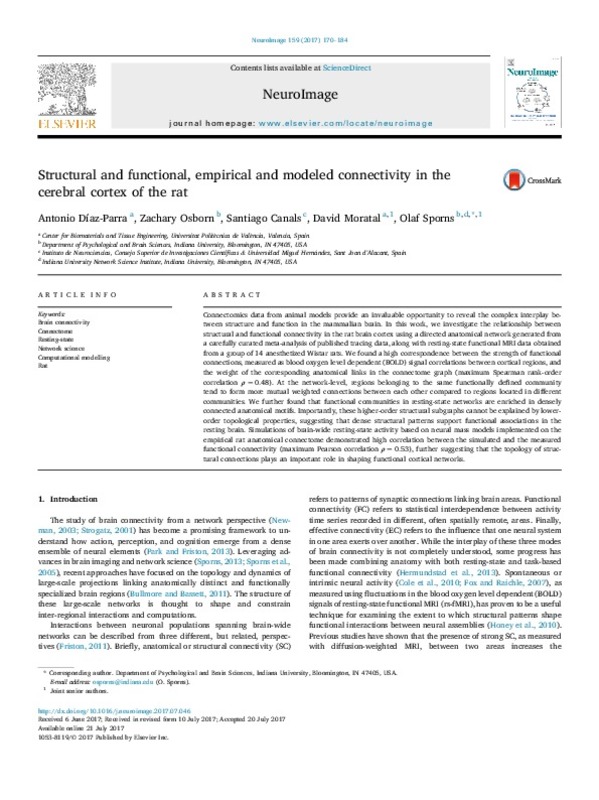JavaScript is disabled for your browser. Some features of this site may not work without it.
Buscar en RiuNet
Listar
Mi cuenta
Estadísticas
Ayuda RiuNet
Admin. UPV
Structural and functional, empirical and modeled connectivity in the cerebral cortex of the rat
Mostrar el registro sencillo del ítem
Ficheros en el ítem
| dc.contributor.author | Díaz-Parra, Antonio
|
es_ES |
| dc.contributor.author | Osborn, Z.
|
es_ES |
| dc.contributor.author | Canals Gamoneda, Santiago
|
es_ES |
| dc.contributor.author | Moratal, David
|
es_ES |
| dc.contributor.author | Sporns, O.
|
es_ES |
| dc.date.accessioned | 2018-05-18T07:30:47Z | |
| dc.date.available | 2018-05-18T07:30:47Z | |
| dc.date.issued | 2017 | es_ES |
| dc.identifier.issn | 1053-8119 | es_ES |
| dc.identifier.uri | http://hdl.handle.net/10251/102205 | |
| dc.description.abstract | [EN] Connectomics data from animal models provide an invaluable opportunity to reveal the complex interplay between structure and function in the mammalian brain. In this work, we investigate the relationship between structural and functional connectivity in the rat brain cortex using a directed anatomical network generated from a carefully curated meta-analysis of published tracing data, along with resting-state functional MRI data obtained from a group of 14 anesthetized Wistar rats. We found a high correspondence between the strength of functional connections, measured as blood oxygen level dependent (BOLD) signal correlations between cortical regions, and the weight of the corresponding anatomical links in the connectome graph (maximum Spearman rank-order correlation rho = 0.48). At the network-level, regions belonging to the same functionally defined community tend to form more mutual weighted connections between each other compared to regions located in different communities. We further found that functional communities in resting-state networks are enriched in densely connected anatomical motifs. Importantly, these higher-order structural subgraphs cannot be explained by lower-order topological properties, suggesting that dense structural patterns support functional associations in the resting brain. Simulations of brain-wide resting-state activity based on neural mass models implemented on the empirical rat anatomical connectome demonstrated high correlation between the simulated and the measured functional connectivity (maximum Pearson correlation rho = 0: 53), further suggesting that the topology of structural connections plays an important role in shaping functional cortical networks. | es_ES |
| dc.description.sponsorship | This work was supported in part by the Spanish Ministerio de Economia y Competitividad (MINECO) and FEDER funds under grants BFU2015-64380-C2-1-R (S.C) and BFU2015-64380-C2-2-R (D.M.) and EU Horizon 2020 Program 668863-SyBil-AA grant (S.C.). S.C. acknowledges financial support from the Spanish State Research Agency, through the "Severo Ochoa" Programme for Centres of Excellence in R&D (ref. SEV-2013-0317). A. D.-P., was supported by grant FPU13/01475 from the Spanish Ministerio de Educacion, Cultura y Deporte (MECD). O.S. acknowledges support by the J.S. McDonnell Foundation (#220020387) and the National Institutes of Health (NIH R01 AT009036-01). We are also grateful to Andrea Avena-Koenigsberger and Begona Fernandez for their technical support. | es_ES |
| dc.language | Inglés | es_ES |
| dc.publisher | Elsevier | es_ES |
| dc.relation.ispartof | NeuroImage | es_ES |
| dc.rights | Reconocimiento - No comercial - Sin obra derivada (by-nc-nd) | es_ES |
| dc.subject | Brain connectivity | es_ES |
| dc.subject | Connectome | es_ES |
| dc.subject | Resting-state | es_ES |
| dc.subject | Network science | es_ES |
| dc.subject | Computational modelling | es_ES |
| dc.subject | Rat | es_ES |
| dc.subject.classification | TECNOLOGIA ELECTRONICA | es_ES |
| dc.title | Structural and functional, empirical and modeled connectivity in the cerebral cortex of the rat | es_ES |
| dc.type | Artículo | es_ES |
| dc.identifier.doi | 10.1016/j.neuroimage.2017.07.046 | es_ES |
| dc.relation.projectID | info:eu-repo/grantAgreement/EC/H2020/668863/EU/Systems Biology of Alcohol Addiction: Modeling and validating disease state networks in human and animal brains for understanding pathophysiolgy, predicting outcomes and improving therapy/ | en_EN |
| dc.relation.projectID | info:eu-repo/grantAgreement/MINECO//BFU2015-64380-C2-2-R/ES/ANALISIS DE TEXTURAS EN IMAGEN CEREBRAL MULTIMODAL POR RESONANCIA MAGNETICA PARA UNA DETECCION TEMPRANA DE ALTERACIONES EN LA RED Y BIOMARCADORES DE ENFERMEDAD/ | es_ES |
| dc.relation.projectID | info:eu-repo/grantAgreement/MECD//FPU13%2F01475/ES/FPU13%2F01475/ | es_ES |
| dc.relation.projectID | info:eu-repo/grantAgreement/NIH/NATIONAL CENTER FOR COMPLEMENTARY & INTEGRATIVE HEALTH/5R01AT009036-03/US/ | |
| dc.rights.accessRights | Abierto | es_ES |
| dc.contributor.affiliation | Universitat Politècnica de València. Departamento de Ingeniería Electrónica - Departament d'Enginyeria Electrònica | es_ES |
| dc.description.bibliographicCitation | Díaz-Parra, A.; Osborn, Z.; Canals Gamoneda, S.; Moratal, D.; Sporns, O. (2017). Structural and functional, empirical and modeled connectivity in the cerebral cortex of the rat. NeuroImage. 159:170-184. https://doi.org/10.1016/j.neuroimage.2017.07.046 | es_ES |
| dc.description.accrualMethod | S | es_ES |
| dc.relation.publisherversion | https://doi.org/10.1016/j.neuroimage.2017.07.046 | es_ES |
| dc.description.upvformatpinicio | 170 | es_ES |
| dc.description.upvformatpfin | 184 | es_ES |
| dc.type.version | info:eu-repo/semantics/publishedVersion | es_ES |
| dc.description.volume | 159 | es_ES |
| dc.identifier.pmid | 28739119 | en_EN |
| dc.identifier.pmcid | PMC5724396 | en_EN |
| dc.relation.pasarela | S\353074 | es_ES |
| dc.contributor.funder | Ministerio de Educación, Cultura y Deporte | es_ES |
| dc.contributor.funder | Ministerio de Economía y Competitividad | es_ES |








